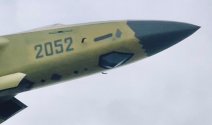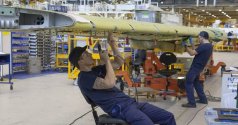A photo of it moment (second) before was taken in October 2023 and posted in #497
Yes and a part of it was also posted in smaller size

A photo of it moment (second) before was taken in October 2023 and posted in #497

This image of a J-20 (potentially A?) was released by the AVIC along with a bunch others, but only this image features a yellow one.
And if you zoom in close enough, you can see a faint outline beyond the cockpit glass. So potentially one with the cockpit hump?
View attachment 123623
Or maybe I'm just delusional
Oh, I'm definitely not treating it as conclusive proof. Merely hypothesising with what may or may not be context cluesBeing in yellow primer is not conclusive proof in and of itself. Every newly produced bird will test fly in yellow primer before it is accepted by Air Force.
This image of a J-20 (potentially A?) was released by the AVIC along with a bunch others, but only this image features a yellow one.
And if you zoom in close enough, you can see a faint outline beyond the cockpit glass. So potentially one with the cockpit hump?
View attachment 123623
Or maybe I'm just delusional
Is it normal for hand drivers to be used for this application? I thought all aircraft screws would be precisely torque limited.This image in and of itself is nothing special, but it is the first that I have seen that shows the body panels/access panels in the process of being screwed down.

Is it normal for hand drivers to be used for this application? I thought all aircraft screws would be precisely torque limited.
I wouldn't say a cheap cordless driver you get from the hardware store is anywhere precise enough for aviation work, but I'll concede that you can indeed buy cordless torque drivers for few thousand a piece so you're indeed correct.You can get cordless screwdrivers with torque control for as low as 70, 80 bucks. It's a widely available product.

